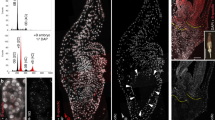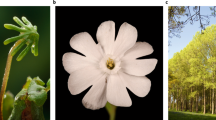Abstract
PIERCE1, in 1937, claimed to have effected large changes in chromosome size in meristematic root tip cells of Viola conspersa after treating seedlings with different culture solutions. For example, he reports that in seedlings grown for 2 months in a culture solution with a large content of phosphate the chromosomes were 300 per cent larger by volume than in seedlings grown in a solution without phosphate. We think that his results provide the only direct evidence to show that changes in chromosome size may be induced by external environmental influences. The results pose two questions of particular interest. First, did the induced changes in chromosome volume reflect changes in chromosome mass or merely represent changes in the organization, for example, the coiling, of the chromosome material ? Second, were the induced changes associated with quantitative changes in chromosomal DNA and possibly, therefore, in genetic information ? This question is especially pertinent because variation in chromosome size between different individuals is, normally, positively correlated with changes in the quantity of nuclear DNA2,3. The following is a brief account of an experiment with seedlings of rye (Secale cereale, 2n = 14). The experiment completely confirms Pierce's results in showing that changes in chromosome size may readily be induced. The experiment also provides answers to the above questions in relation to chromosome mass and chromosomal DNA. In addition the experiment brings to light a variation in chromosome size, independent of the inducing treatments, that seems to be associated with the “ageing” of the seedlings.
This is a preview of subscription content, access via your institution
Access options
Subscribe to this journal
Receive 51 print issues and online access
$199.00 per year
only $3.90 per issue
Buy this article
- Purchase on Springer Link
- Instant access to full article PDF
Prices may be subject to local taxes which are calculated during checkout
Similar content being viewed by others
References
Pierce, W. P., Bull. Torrey Club, 64, No. 6 (1937).
Darlington, C. D., Cytology (J. and A. Churchill Ltd., London, 1965).
Rees, H., Cameron, F. M., Hazarika, M. H., and Jones, G. H., Nature, 211, 828 (1966).
Richards, B. M., The Cell Nucleus (Butterworth and Co. Ltd., London, 1960).
McLeish, J., Proc. Roy. Soc., B, 158, 261 (1963).
Lewis, K. R., and John, B., Chromosome Marker (J. and A. Churchill, Ltd., 1963).
Author information
Authors and Affiliations
Rights and permissions
About this article
Cite this article
BENNETT, M., REES, H. Natural and Induced Changes in Chromosome Size and Mass in Meristems. Nature 215, 93–94 (1967). https://doi.org/10.1038/215093a0
Received:
Issue Date:
DOI: https://doi.org/10.1038/215093a0
This article is cited by
-
State-of-the-art and novel developments of in vivo haploid technologies
Theoretical and Applied Genetics (2019)
-
Change in chromosome concept
Proceedings / Indian Academy of Sciences (1978)
-
Chromosome weights and measures in the Triticinae
Heredity (1970)
-
Do Genes determine Sex?
Nature (1969)
-
The relationship between DNA value and chromosome volume in the coleopteran genus Dermestes
Chromosoma (1969)
Comments
By submitting a comment you agree to abide by our Terms and Community Guidelines. If you find something abusive or that does not comply with our terms or guidelines please flag it as inappropriate.



